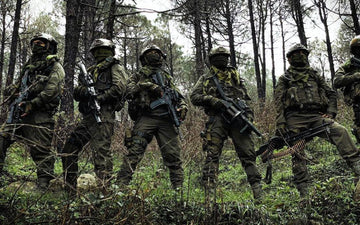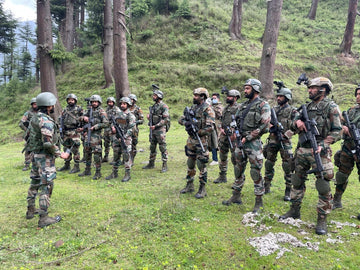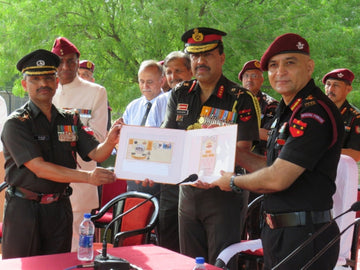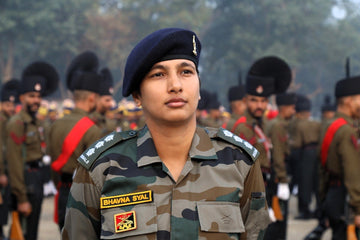The Indian Air Force (IAF) plays a significant role in safeguarding the country's skies and national security. Among the various ranks that contribute to this effort, the position of a Flying Officer stands out, representing both an elite corps of aviators and a vital role in India's military framework. The question many potential candidates and interested observers often have is, "What’s the compensation structure like for these officers?" Understanding the salary, allowances, and perks associated with the role not only sheds light on the value of service in the IAF but also the incentives designed to attract the best talents.
Historical Context
The evolution of the Indian Air Force has been intertwined with the history of military aviation in India, spanning over eight decades since its inception in 1932. Initially established as a small force with limited aircraft, the IAF has grown into a formidable aerial arm of the Indian Armed Forces, participating in numerous conflicts and peacekeeping missions over the years. The remuneration structure for officers, including Flying Officers, has also evolved, aligning with changes in governance, economic factors, and the need to retain skilled professionals.
The implementation of the 7th Pay Commission, which was established to revise the pay scales for government employees, marked a significant transition in how Flying Officers are compensated. Understanding how these historical shifts influence current remuneration packages is crucial for appreciating the value accorded to a career in the IAF.
Basic Pay Structure
At the heart of the compensation for a Flying Officer is the basic pay. As per the 7th Pay Commission, Flying Officers fall under Level 10 of the Pay Matrix, with a basic pay ranging from ₹56,100 to ₹1,77,500 per month. This range is influenced by factors such as years of service, rank, and promotions attained during an officer's career. Here’s a more detailed breakdown of the pay structure:
-
Entry Level Pay: Newly commissioned Flying Officers commence their careers at ₹56,100 per month.
-
Promotion Impact: With subsequent promotions, the pay can increase significantly, rewarding experience and loyalty to the IAF.
-
Comparison with Other Services: The basic pay is competitive not only within the Indian Armed Forces but also when compared to similar roles in civilian sectors.
This structured approach ensures that remuneration reflects both the commitment of the officers and the expectations of high performance and accountability.
Allowances: Enhancing the Compensation Package
The salary of a Flying Officer is augmented significantly through various allowances designed to address the unique challenges of military life. These allowances cover aspects ranging from service-specific requirements to generous support for families. Here’s an overview of the prominent allowances available to Flying Officers:
-
Military Service Pay (MSP): This is a fixed monthly allowance granted to armed forces personnel, set at ₹15,500 per month.
-
Flying Allowance: A crucial component for those in the flying branch, this allowance aims to compensate officers for the additional risks and responsibilities associated with flying duties. There’s some discrepancy in reported numbers, with flying allowances stated as ₹25,000 or ₹11,250 per month in various contexts. The former likely aligns with the more current compensation structure.
-
Transport Allowance: This allowance is applicable based on the location of posting and aims to assist with travel-related expenses.
-
Children Education Allowance: Offered to support the educational expenses of officers' children, recognizing the important role family considerations play in posting decisions.
-
House Rent Allowance (HRA): Agents that vary based on place of residence, HRA is crucial for officers posted in metropolitan cities where living costs can be exorbitant.
-
Special Compensatory Allowances: These allowances are designated for personnel deployed to challenging environments, such as hill stations, fields, or Siachen.
Perks and Benefits: A Holistic Package
Beyond the direct financial compensation, the Indian Air Force provides a robust suite of perks and benefits aimed at enhancing quality of life for Flying Officers and their families.
Accommodation
Flying Officers often enjoy well-furnished housing, which is graded based on their rank. This housing is typically spacious and strategically located near base operations, reducing commute times and enhancing quality of life.
Insurance Cover
A generous insurance policy of ₹30 lakhs, along with an additional ₹3.5 lakhs coverage for Flying Branch Officers, reassures service members and their families of financial security in the event of unforeseen circumstances.
Leave and Travel Benefits
-
Annual Leave: Officers are entitled to 60 days of annual leave, complemented by 20 days of casual leave.
-
Leave Travel Concession (LTC): The IAF provides liberal travel concessions for officers and their families, facilitating periodic travel and family reunions.
Financial Support
Flying Officers have access to low-interest loans through the Air Force Group Insurance Society, covering various needs such as housing, automobiles, and educational expenses. This assistance showcases the commitment of the IAF to support the financial wellbeing of its personnel.
Training Period Benefits
Before taking on the duties of a commissioned Flying Officer, recruits undergo rigorous training at various Air Force Training Institutions. Even during the last year of this training, candidates receive a monthly stipend of ₹56,100. This early financial support serves as an incentive for prospective officers and acknowledges the importance of training in preparing effective military leaders.
Other Benefits: Continuous Development
The IAF places a strong emphasis on professional development, offering various training programs that improve skills and advance career prospects. Continuous learning not only enhances operational effectiveness but also positions Flying Officers for future promotions and raises in pay.
Case Studies or Real-world Applications
While the theoretical salary structure of a Flying Officer is well-documented, examining case studies and personal narratives can help contextualize these numbers against the lived experience of IAF personnel.
For instance, consider the story of Flight Lieutenant Riya Sharma, a dynamic and highly decorated officer who has served in various capacities within the IAF. Tracking her journey from entry-level Flying Officer to her recent promotion to squadron leader illustrates the financial and professional rewards attainable through dedication and resilience.
Her transition was marked not only by the financial benefits accrued but also by a rich tapestry of experiences ranging from humanitarian missions to multilateral exercises with partner nations.
Riya’s experience emphasizes the importance of the financial package in enabling personal and professional aspirations—supporting her education, affording her family a comfortable lifestyle, and empowering her participation in high-profile missions.
Statistical Data and Research Insights
Understanding the compensation structure of Flying Officers in the IAF necessitates digging into the broader context of defence salaries across India. According to recent reports from various budget analyses, military personnel's compensation, including allowances, occupies a substantial portion of the national defence expenditure. For instance:
-
Budget Allocation: The defence budget has consistently seen allocations toward salaries and pensions, indicative of an effort to retain skilled personnel.
-
Salary Growth: Between the 6th and 7th Pay Commissions, there was a reported increase of around 23% in average salary structures for military personnel, which reflects the growing recognition of the sacrifices made by members of the armed forces.
Comparative Analysis
When comparing the compensation of Flying Officers with those in similar civilian roles, such as airline pilots, some differences arise. For instance, while civilian pilots may command higher salaries in certain private sectors, they may lack the comprehensive benefits, job security, and retirement plans offered to Armed Forces personnel. Military life entails unique sacrifices, including relocations and the demands of service that one must weigh against civilian employment.
Challenges and Solutions
Despite a competitive compensation package, challenges remain in attracting and retaining talented young people in the IAF. Work-life balance, family separation due to postings, and the psychological impact of military service can deter some prospective candidates.
Proposed Solutions
-
Enhanced Family Support: Programs focusing on family integration during postings can improve morale and retention.
-
Career Flexibility: Introducing more opportunities for specialization and career advancement can pique the interest of millennials seeking a diversified career path.
-
Strengthened Mental Health Resources: Increased access to mental health resources can help alleviate the psychological stresses associated with military life.
Future Trends and Predictions
Looking to the future, the compensation package for Flying Officers in the IAF may evolve further to adapt to the changing landscape of modern warfare and technology. The introduction of more advanced aircraft, the necessity for continuous training, and growing cybersecurity threats will necessitate skilled personnel who are adequately compensated and incentivized.
With ongoing discussions about defence budgets and recruitment strategies, there will likely be continued analysis and potential revisions of the salary and perks to remain competitive in the global military landscape.
Conclusion
The compensation package for Flying Officers in the Indian Air Force is a comprehensive and well-structured system designed to reflect the complexities and demands of military service. From basic pay to a myriad of allowances and perks, these financial incentives serve not only to reward but to attract the best talent to safeguard India's skies.
For aspiring candidates considering a future as a Flying Officer, understanding these intricacies—combined with the chance to serve the nation—can make an impressionable statement about the allure of a military career. As the IAF continues to evolve, so too will the rewards that accompany this prestigious role, ensuring that service members are recognized for their dedication and sacrifices.
Prospective candidates can explore relevant preparation resources through institutions such as SSBCrack and SSBCrackExams to ensure they are well-equipped to embark on this noble journey.





